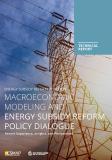Publications
This note comes in three sections. First, the information required for political economy analysis of energy subsidy reforms is presented. Second, a summary is given of the information that can usually be obtained through desk research to provide the context for subsequent interviews and another field research. Third, information that probably requires interviews and field data collection is provided. The ultimate audience of the proposed types of analysis lies with policy reformers themselves and with external development and policy institutions that are seeking to help governments adopt more sustainable reforms. However, the direct audience for this note are those commissioning political economy analysis of energy subsidies, and technocrats, researchers, and advisers to policy makers carrying out the analysis.
Often, a team made up of sector experts and political economy experts will provide a greater depth of analysis. Significant attention is devoted here to the origins and operation of existing subsidies since that history conditions what is possible for the adoption and sustainability of future reforms. The main interest and audience for this note is forward-looking, people and institutions who need to understand what is politically possible and how to realign political forces around successful reform. The authors are mindful that this role is perhaps different from other more technocratic roles of agencies and institutions focused on technical analysis and thus they also devote some attention to the processes needed to obtain and manage sensitive information and political insights since mismanagement in that realm can, itself, affect the political prospects for reform and harm the standing of reform agents in the process. In contrast to desk research or analysis of existing datasets, field research on political economy will always be an intervention in the local system, which needs to be managed well to increase and not decrease the space for reform and coalition building.
ESRAF Good Practice Overview: Guidance for Comprehensive Energy Subsidy Reforms
ESRAF Good Practice Note 1: Identifying and Quantifying Energy Subsidies
ESRAF Good Practice Note 2: Assessing the Fiscal Cost of Subsidies and Fiscal Impact of Reform
ESRAF Good Practice Note 6 to come: Identifying the Impacts of Higher Energy Prices on Firms and Industrial Competitiveness
ESRAF Good Practice Note 7: Modeling Macroeconomic Impacts and Global Externalities
ESRAF Good Practice Note 10: Designing Communication Campaigns for Energy Subsidy Reform
Inchauste, Gabriela; Victor, David G.; Schiffer, Eva. 2018. Assessing the Political Economy of Energy Subsidies to Support Policy Reform Operations: Energy Subsidy Reform Assessment Framework (ESRAF) Good Practice Note 9. ESMAP Paper. Washington, D.C.: World Bank Group.




